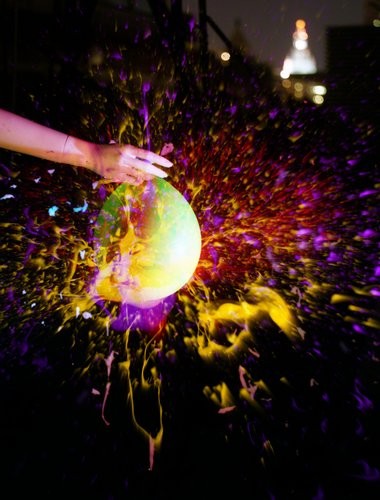Patterson Beckwith
21 Feb - 21 Mar 2009

© Patterson Beckwith
Untitled (Balloon Exploding/City Hall Strobograph ii, 20 μs x 5, 2008).
C-print
16 x 20
Untitled (Balloon Exploding/City Hall Strobograph ii, 20 μs x 5, 2008).
C-print
16 x 20
PATTERSON BECKWITH
February 21- March 21, 2009
Opening Reception: Sunday, February 22, 7-9 pm
Mesler&Hug is pleased to present Patterson Beckwith’s second solo exhibition at the gallery. The 20 photographs that Beckwith exhibits are called strobographs, meaning that each event is photographed up to six times as it elapses. Several strobe lights (each with different neoncolored gels) are set up in a completely dark room, and are triggered by the sound or movement of the event, and according to the settings of an electronic delay circuit, they fire in sequence. This produces a multiple exposure negative of the event as it takes place. The camera lens is open for an extended period (which is made possible by a completely dark environment), and the exposures are actually made by the flashes as they fire, triggered by the event itself. In effect, the photographs depict different staged, high-speed events, which are documented strobographically by means of multiple exposures on a single sheet of film, over a very brief (less than 1⁄2 second) period of time. They are time-lapse records of events such as a cheeseburger exploding, or the popping of a balloon. In the end, Beckwith’s photographs display neon-tinted objects from everyday life (toys, food, light bulbs) exploding into the air.
Beckwith references the research of high-speed photography done by Harold Edgerton for this project. He is interested in pictures of time, rather than images in time, and how this technique when used, creates these stopped images of extreme speed, slowed down to a moment when an explosion is captured and all of the frames are visible.
Beckwith lives and works in New York. He earned his M.F.A. from UCLA and his B.F.A. at The Cooper Union. He has exhibited at the Aspen Art Museum (2009), Greene-Naftali (2007), (2000), among others. Beckwith is also a founding member of Art Club 2000, formed in 1992 with Collin de Land.
February 21- March 21, 2009
Opening Reception: Sunday, February 22, 7-9 pm
Mesler&Hug is pleased to present Patterson Beckwith’s second solo exhibition at the gallery. The 20 photographs that Beckwith exhibits are called strobographs, meaning that each event is photographed up to six times as it elapses. Several strobe lights (each with different neoncolored gels) are set up in a completely dark room, and are triggered by the sound or movement of the event, and according to the settings of an electronic delay circuit, they fire in sequence. This produces a multiple exposure negative of the event as it takes place. The camera lens is open for an extended period (which is made possible by a completely dark environment), and the exposures are actually made by the flashes as they fire, triggered by the event itself. In effect, the photographs depict different staged, high-speed events, which are documented strobographically by means of multiple exposures on a single sheet of film, over a very brief (less than 1⁄2 second) period of time. They are time-lapse records of events such as a cheeseburger exploding, or the popping of a balloon. In the end, Beckwith’s photographs display neon-tinted objects from everyday life (toys, food, light bulbs) exploding into the air.
Beckwith references the research of high-speed photography done by Harold Edgerton for this project. He is interested in pictures of time, rather than images in time, and how this technique when used, creates these stopped images of extreme speed, slowed down to a moment when an explosion is captured and all of the frames are visible.
Beckwith lives and works in New York. He earned his M.F.A. from UCLA and his B.F.A. at The Cooper Union. He has exhibited at the Aspen Art Museum (2009), Greene-Naftali (2007), (2000), among others. Beckwith is also a founding member of Art Club 2000, formed in 1992 with Collin de Land.
